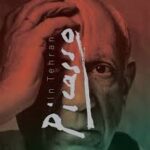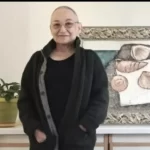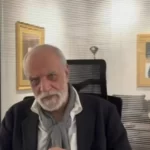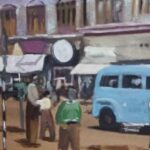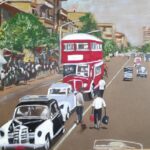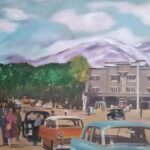
Aydin Aghdashloo (born November 8, 1941, in Rasht) is an Iranian painter, graphic designer, writer, and art critic known for his unique style that blends classical Iranian elements with modernism. He developed an interest in art at a young age and began his studies at the Faculty of Fine Arts, University of Tehran, but left them incomplete. Despite this, he had a significant impact in the fields of painting, illustration, and curating.
Aghdashloo is best known for his collections “Memories of Destruction” and “Years of Fire and Snow,” which address themes of decay, nostalgia, and the history of Iranian art. He has also been active in art education and art criticism, collaborating with various cultural and artistic centers.
After his last exhibition in 2018 at the Sihoon Gallery, Aghdashloo held a new exhibition of his works at Gallery B after seven years. This exhibition, curated by Tekin Aghdashloo, provided an opportunity for art lovers and enthusiasts to witness the evolution and expansion of the artist’s artistic language.
The exhibition featured seven paintings and seven prints, each reflecting Aghdashloo’s unique style and visual language. A special highlight was the display of three sculptures by Aghdashloo, which were shown to the public for the first time. These sculptures, including the bronze works “Snow,” “Apocalypse,” and “Identity,” were based on the visual world of his well-known paintings, with familiar motifs reinterpreted in new and innovative ways.
The unveiling ceremony of Aydin Aghdashloo’s book and a short documentary about the artist’s life, directed by Tara Aghdashloo, was held at the opening of his exhibition, receiving an exceptional response from artists, art enthusiasts, and cultural figures. Following the ceremony, a part of the exhibition showcased 17 key works from the most important periods of Aghdashloo’s career, including some of his finest works. These pieces not only reflect Aghdashloo’s vision and thinking but also showcase the intellectual discourse he has adhered to for over half a century. Works such as the collections “Memories of Destruction,” “Crushed Miniatures,” “Deformed Faces,” “Unattainable Lovers,” and many others vividly reveal the depth and diversity of Aghdashloo’s perspective.
Aghdashloo’s recent exhibition offers another opportunity to engage with the complex and beautiful world of Iranian art. This new collection, like his previous works, reflects a profound understanding of the internal and external contradictions of humans, particularly regarding Iranian history, culture, and identity. By using vibrant colors, clearlines, and geometric shapes, Aghdashloo addresses social and cultural complexities while offering a deep look at the current position of people in today’s Iran.
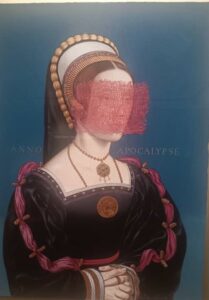
This collection not only draws inspiration from historical events but also pays special attention to contemporary social issues. His varied painting techniques, especially powerful colors and intricate textures, are a testament to his ability to bridge the gap between tradition and modernity. Aghdashloo’s works raise philosophical and cultural questions that concern not only Iranian identity but also collective humanity in today’s world.
With his distinctive style of using colors, lines, and textures, this collection reaffirms Aghdashloo’s deep connection with Iranian history, culture, and identity. The exhibition sets new boundaries in the art of painting and visually portrays Aghdashloo’s contemporary viewpoints on social, cultural, and personal topics.
In this collection, the artist emphasizes the contradictions within and between humans, attempting to portray the distances between individual and collective consciousness through powerful visual representations. His works, which combine bold colors and intricate geometric shapes, reflect both Iran’s cultural past and its current challenges. Aghdashloo uses various techniques, from painting to watercolor, to convey social and cultural realities, while simultaneously presenting philosophical and cultural questions to the audience.
For a more precise critique of this exhibition’s works, one must analyze the details of each piece and how the techniques employed, the underlying messages, and their impact on the audience and contemporary art spaces are reflected.
In this piece, Aydin Aghdashloo once again plays with our visual memory, depicting the game of oblivion and decay. The face of a woman seems to have emerged from the heart of classical art history, softly fading with colors and textures. It’s as though a past that was once clear and vivid is now lost in a mist of ambiguity.
The red fabric, slowly obscuring her face, not only evokes the censorship and bitter silence of the past but could also symbolize the hidden violence in the history of women. The woman, delicately and intricately depicted, ultimately becomes a faceless being—perhaps representing forgetfulness or a memory that history no longer wishes to preserve.
The pure blue background contrasts with the woman’s dark clothing, detaching her from her temporal roots and suspending her in a space between the past and the present. In this context, the phrase “Anno Apocalypse” seems to act as a silent warning: questioning whether the apocalypse is a fate handed down from the past or a predestined future awaiting us.
By removing the face, Aghdashloo eliminates the woman’s identity, transforming her into a symbol beyond an individual—representing the manifestation of fate, history, and oblivion. The work gently conveys a sense of sorrow and anxiety, as though the painting is slowly fading before our eyes.
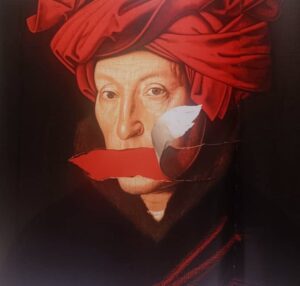
In Aydin Aghdashloo’s paintings, the absence of lips and mouths in the faces usually carries a deep and layered message. This feature could have several meanings:
Silence and Inability to Express: When the mouth is absent from an image, it may suggest that the characters cannot express themselves or are unable to speak about something. It can symbolize silence or the suppression of emotions and thoughts.
Non-Verbal Expression: By removing the mouth, Aghdashloo emphasizes that humans don’t only speak through words. Eyes and facial expressions can convey deeper emotions and thoughts.
Identity Crisis: These works may represent an identity crisis, where characters do not know what they want to express or communicate. It can refer to a sense of confusion in understanding oneself.
Beginning or End of Something: The removal of the mouth can signify the start or end of a phase in an individual’s life or identity, as if part of the individual’s identity has been severed, leading them to a new stage.
These features in Aghdashloo’s paintings are a beautiful combination of Iranian art and modernism, expressing complex and diverse concepts about the human condition today.
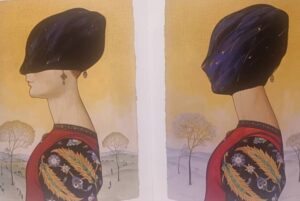
In Aydin Aghdashloo’s works, the covering or absence of faces is a distinctive and meaningful feature that can carry multiple messages:
Identity Confusion: When faces are concealed, it seems as though the individual’s identity is lost, making it impossible to easily understand their emotions or personality. This may indicate an identity crisis or a doubt about the self.
Separation from Individuality: By covering the faces, Aghdashloo may want to show that the focus is not on personal features but rather on a more social and public aspect of humanity.
Criticism of Surveillance and Repression: The covering of faces could refer to the social pressures or surveillance individuals face. It’s as if the faces are deliberately hidden so that the person cannot freely express themselves.
Silence: Similar to the absence of the mouth, covering the face can also symbolize silence. It seems as if people cannot speak or fully reveal themselves.
Overall, covering faces in Aghdashloo’s works makes the viewer pay attention to deeper concepts like identity, social pressures, and personal limitations. It gives his works a sense of mystery, prompting us to challenge ourselves beyond appearances.
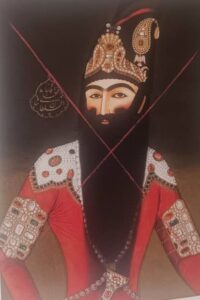
The use of a red pencil line drawn over the faces of famous people and figures in paintings often symbolizes disrespect or social critique. This action may have several meanings:
Criticism of Fame and Social Patterns: By drawing a red line over the faces of famous individuals, the artist may be critiquing the social and cultural systems that elevate people as idealized figures. This act can symbolize the breaking of an idealized image and the revealing of their humanity.
Separation or Disconnect: The red line could symbolize distancing or separating a character from social and political contexts. It may represent the distancing from common opinions or ideologies.
Marking or Devaluing Values: Drawing a red line over a person’s face might be seen as a way of eliminating or devaluing the positive or famous traits of an individual. It may be a critique of the individual or the systems that give them credibility.
Showing Power and Control: In some cases, the red line could symbolically represent the artist’s or an individual’s power. By drawing a red line, they place themselves in a superior position, indicating their ability to manipulate or alter the image of the famous.
Overall, drawing a red pencil line over the faces of famous individuals is often a reaction to societal and cultural structures, with the intent of critiquing, protesting, or challenging prevailing norms.
In conclusion, Aydin Aghdashloo’s works in his latest exhibition, which included paintings and sculptures, uniquely displayed the complex relationship between humans and Iranian history, identity, and culture. Using his distinct techniques, including the removal of faces and lack of mouths in the characters, he addressed deeper concepts of silence, identity crises, and social repression. The colors, textures, and geometric shapes in his works convey the link between tradition and modernity while engaging with today’s challenges in Iran. These pieces not only emphasize Iranian history and identity but also raise philosophical questions about the current human and social condition. Overall, through these works, the artist invites the audience to reflect deeply on identity, culture, and social issues, while setting new boundaries in contemporary art.
Houra Khakdaman / artist, and Art Critic
article links:
